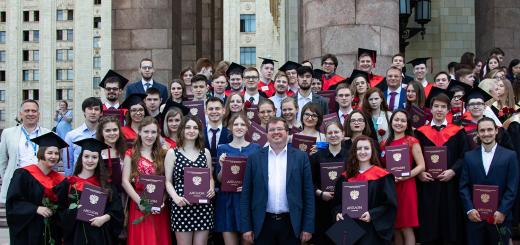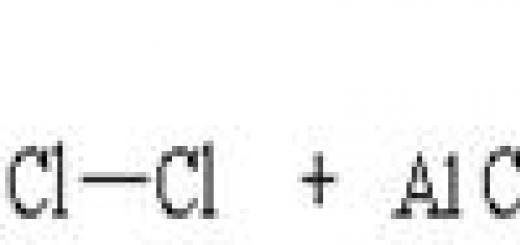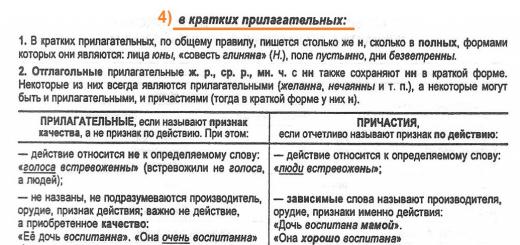The kinetic energy of a rotating body is equal to the sum of the kinetic energies of all particles of the body:
The mass of a particle, its linear (circumferential) speed, proportional to the distance of this particle from the axis of rotation. Substituting into this expression and taking the angular velocity o common for all particles out of the sum sign, we find:
![]()
This formula for the kinetic energy of a rotating body can be brought to a form similar to the expression for the kinetic energy of translational motion if we introduce the value of the so-called moment of inertia of the body. The moment of inertia of a material point is the product of the mass of the point and the square of its distance from the axis of rotation. The moment of inertia of a body is the sum of the moments of inertia of all material points of the body:
So, the kinetic energy of a rotating body is determined by the following formula:
Formula (2) differs from the formula that determines the kinetic energy of a body in translational motion in that instead of the mass of the body it includes the moment of inertia I and instead of the speed the group velocity
The large kinetic energy of a rotating flywheel is used in technology to maintain uniform running of the machine under suddenly changing loads. Initially, in order to bring a flywheel with a large moment of inertia into rotation, a significant amount of work is required from the machine, but when a large load is suddenly turned on, the machine does not stop and does the work using the reserve of kinetic energy of the flywheel.
Especially massive flywheels are used in rolling mills driven by an electric motor. Here is a description of one of these wheels: “The wheel has a diameter of 3.5 m and weighs. At a normal speed of 600 rpm, the reserve of kinetic energy of the wheel is such that at the moment of rolling the wheel gives the mill a power of 20,000 liters. With. Friction in the bearings is reduced to a minimum by the tale under pressure, and in order to avoid the harmful effects of centrifugal forces of inertia, the wheel is balanced so that a load placed on the circumference of the wheel brings it out of rest."
Let us present (without performing calculations) the values of the moments of inertia of some bodies (it is assumed that each of these bodies has the same density in all its areas).
The moment of inertia of a thin ring relative to an axis passing through its center and perpendicular to its plane (Fig. 55):
The moment of inertia of a circular disk (or cylinder) about an axis passing through its center and perpendicular to its plane (polar moment of inertia of the disk; Fig. 56):
The moment of inertia of a thin round disk relative to an axis coinciding with its diameter (equatorial moment of inertia of the disk; Fig. 57):
The moment of inertia of the ball relative to the axis passing through the center of the ball:
Moment of inertia of a thin spherical layer of radius about an axis passing through the center:
The moment of inertia of a thick spherical layer (a hollow ball having an outer surface radius and a cavity radius) about an axis passing through the center:
![]()



The moments of inertia of bodies are calculated using integral calculus. To give an idea of the progress of such calculations, let us find the moment of inertia of the rod relative to the axis perpendicular to it (Fig. 58). Let there be a cross section of the rod, density. Let us select an elementary small part of the rod, which has a length and is located at a distance x from the axis of rotation. Then its mass Since it is at a distance x from the axis of rotation, its moment of inertia is integrated over the range from zero to I:

Moment of inertia of a rectangular parallelepiped relative to the axis of symmetry (Fig. 59)
![]()
Moment of inertia of the ring torus (Fig. 60)
![]()
Let us consider how the rotational energy of a body rolling (without sliding) along a plane is related to the energy of the translational motion of this body,
The energy of translational motion of a rolling body is equal to , where is the mass of the body and the speed of translational motion. Let denote the angular velocity of rotation of a rolling body and the radius of the body. It is easy to understand that the speed of translational motion of a body rolling without sliding is equal to the peripheral speed of the body at the points of contact of the body with the plane (during the time when the body makes one revolution, the center of gravity of the body moves a distance, therefore,
Thus,
![]()
Rotation energy
![]()
hence,
![]()


Substituting here the above values of the moments of inertia, we find that:
a) the energy of the rotational motion of a rolling hoop is equal to the energy of its translational motion;
b) the rotational energy of a rolling homogeneous disk is equal to half the energy of translational motion;
c) the rotational energy of a rolling homogeneous ball is the energy of translational motion.
Dependence of the moment of inertia on the position of the axis of rotation. Let the rod (Fig. 61) with the center of gravity at point C rotate with angular velocity (o around the axis O, perpendicular to the plane of the drawing. Let us assume that over a certain period of time it has moved from position A B to and the center of gravity has described an arc. This movement of the rod can be considered as if the rod first translationally (i.e., remaining parallel to itself) moved to position and then rotated around C to position Let us denote (the distance of the center of gravity from the axis of rotation) by a, and the angle by When the rod moves from position A B to position, the movement of each of its particles is the same as the movement of the center of gravity, i.e., it is equal to or around an axis passing through O can be decomposed into two parts.
Let us consider an absolutely rigid body rotating about a fixed axis. Let's mentally break this body into infinitely small pieces with infinitely small sizes and masses m v t., t 3,... located at distances R v R 0 , R 3,... from the axis. Kinetic energy of a rotating body we find it as the sum of the kinetic energies of its small parts:
- moment of inertia of a rigid body relative to a given axis 00,. From a comparison of the formulas for the kinetic energy of translational and rotational motions, it is obvious that the moment of inertia in rotational motion is analogous to mass in translational motion. Formula (4.14) is convenient for calculating the moment of inertia of systems consisting of individual material points. To calculate the moment of inertia of solid bodies, using the definition of the integral, you can transform it to the form
It is easy to notice that the moment of inertia depends on the choice of the axis and changes with its parallel translation and rotation. Let's find the values of the moments of inertia for some homogeneous bodies.
From formula (4.14) it is obvious that moment of inertia of a material point equals
Where T - point mass; R- distance to the axis of rotation.
It is easy to calculate the moment of inertia for hollow thin-walled cylinder(or the special case of a cylinder with a low height - thin ring) radius R relative to the axis of symmetry. The distance to the axis of rotation of all points for such a body is the same, equal to the radius and can be taken out from under the sum sign (4.14):

Rice. 4.5
Solid cylinder(or a special case of a cylinder with low height - disk) radius R to calculate the moment of inertia relative to the axis of symmetry requires calculating the integral (4.15). You can understand in advance that the mass in this case, on average, is concentrated somewhat closer to the axis than in the case of a hollow cylinder, and the formula will be similar to (4.17), but it will contain a coefficient less than unity. Let's find this coefficient. Let a solid cylinder have density p and height A. Let us divide it into hollow cylinders (thin cylindrical surfaces) of thickness dr(Figure 4.5 shows a projection perpendicular to the axis of symmetry). The volume of such a hollow cylinder of radius r is equal to the surface area multiplied by the thickness: dV = 2nrhdr, weight: dm = 2nphrdr, and the moment of inertia in accordance with formula (4.17): dj =
= r 2 dm = 2lr/?g Wr. The total moment of inertia of a solid cylinder is obtained by integrating (summing) the moments of inertia of hollow cylinders:
Search in the same way moment of inertia of a thin rod length L and masses T, if the axis of rotation is perpendicular to the rod and passes through its middle. Let's break this one down


Taking into account the fact that the mass of a solid cylinder is related to density by the formula t = nR 2 hp, we finally have moment of inertia of a solid cylinder:

Rice. 4.6
rod in accordance with fig. 4.6 pieces thick dl. The mass of such a piece is equal to dm = mdl/L, and the moment of inertia in accordance with formula (4.6): dj = l 2 dm = l 2 mdl/L. The total moment of inertia of a thin rod is obtained by integrating (summing) the moments of inertia of the pieces:
Taking the elementary integral gives the moment of inertia of a thin rod of length L and masses T

Rice. 4.7
It is somewhat more difficult to take the integral when searching moment of inertia of a homogeneous ball radius R and mass /77 relative to the axis of symmetry. Let a solid ball have density p. Let's break it down in accordance with Fig. 4.7 for hollow thin cylinders thick dr, the axis of symmetry of which coincides with the axis of rotation of the ball. The volume of such a hollow cylinder of radius G equal to the surface area multiplied by the thickness:
where is the height of the cylinder h found using the Pythagorean theorem:

Then it is easy to find the mass of the hollow cylinder:
![]()
as well as the moment of inertia in accordance with formula (4.15):
The total moment of inertia of a solid ball is obtained by integrating (summing) the moments of inertia of hollow cylinders:

Taking into account the fact that the mass of a solid ball is related to the density of the form-4.
loy T = -npR A y we finally have the moment of inertia about the axis
symmetry of a homogeneous ball of radius R masses T:
1. Consider the rotation of the body around motionless axis Z. Let us divide the whole body into a set of elementary masses m i. Linear speed of elementary mass m i– v i = w R i, where R i– mass distance m i from the axis of rotation. Therefore, kinetic energy i th elementary mass will be equal to ![]() . Total kinetic energy of the body:
. Total kinetic energy of the body: ![]() , here is the moment of inertia of the body relative to the axis of rotation.
, here is the moment of inertia of the body relative to the axis of rotation.
Thus, the kinetic energy of a body rotating about a fixed axis is equal to:
 2. Now let the body rotates relative to some axis, and itself axis moves progressively, remaining parallel to itself.
2. Now let the body rotates relative to some axis, and itself axis moves progressively, remaining parallel to itself.
FOR EXAMPLE: A ball rolling without sliding makes a rotational motion, and its center of gravity, through which the axis of rotation passes (point “O”) moves translationally (Fig. 4.17).
Speed i-that elementary body mass is equal to ![]() , where is the speed of some point “O” of the body; – radius vector that determines the position of the elementary mass relative to point “O”.
, where is the speed of some point “O” of the body; – radius vector that determines the position of the elementary mass relative to point “O”.
The kinetic energy of an elementary mass is equal to:
 NOTE: the vector product coincides in direction with the vector and has a modulus equal to (Fig. 4.18).
NOTE: the vector product coincides in direction with the vector and has a modulus equal to (Fig. 4.18).
Taking this remark into account, we can write that ![]() , where is the distance of the mass from the axis of rotation. In the second term we make a cyclic rearrangement of the factors, after which we get
, where is the distance of the mass from the axis of rotation. In the second term we make a cyclic rearrangement of the factors, after which we get
To obtain the total kinetic energy of the body, we sum this expression over all elementary masses, taking the constant factors beyond the sign of the sum. We get
The sum of elementary masses is the mass of the body “m”. The expression is equal to the product of the mass of the body by the radius vector of the center of inertia of the body (by definition of the center of inertia). Finally, the moment of inertia of the body relative to the axis passing through point “O”. Therefore we can write
![]() .
.
If we take the center of inertia of the body “C” as the point “O”, the radius vector will be equal to zero and the second term will disappear. Then, denoting through – the speed of the center of inertia, and through – the moment of inertia of the body relative to the axis passing through point “C”, we obtain:
![]() (4.6)
(4.6)
Thus, the kinetic energy of a body in plane motion is composed of the energy of translational motion at a speed equal to the speed of the center of inertia, and the energy of rotation around an axis passing through the center of inertia of the body.
Work of external forces during rotational motion of a rigid body.
Let's find the work done by the forces when the body rotates around the stationary Z axis.
Let an internal force and an external force act on the mass (the resulting force lies in a plane perpendicular to the axis of rotation) (Fig. 4.19). These forces perform in time dt job:
Having carried out a cyclic rearrangement of factors in mixed products of vectors, we find:
where , are, respectively, the moments of internal and external forces relative to point “O”.
Summing over all elementary masses, we obtain the elementary work done on the body in time dt:
The sum of the moments of internal forces is zero. Then, denoting the total moment of external forces through , we arrive at the expression:

![]() .
.
It is known that the scalar product of two vectors is a scalar equal to the product of the modulus of one of the vectors being multiplied by the projection of the second to the direction of the first, taking into account that , (the directions of the Z axis coincide), we obtain
![]() ,
,
but w dt=d j, i.e. the angle through which a body turns in time dt. That's why
![]() .
.
The sign of the work depends on the sign of M z, i.e. from the sign of the projection of the vector onto the direction of the vector.
So, when a body rotates, internal forces do no work, and the work of external forces is determined by the formula ![]() .
.
Work done in a finite period of time is found by integration
 .
.
If the projection of the resulting moment of external forces onto the direction remains constant, then it can be taken out of the integral sign:
 , i.e. .
, i.e. .
Those. the work done by an external force during rotational motion of a body is equal to the product of the projection of the moment of the external force on the direction and angle of rotation.
On the other hand, the work of an external force acting on a body goes to increase the kinetic energy of the body (or is equal to the change in the kinetic energy of the rotating body). Let's show this:
 ;
;
Hence,
![]() . (4.7)
. (4.7)
On one's own:
Elastic forces;
Hooke's law.
| LECTURE 7 |
Hydrodynamics
Current lines and tubes.
 Hydrodynamics studies the movement of liquids, but its laws also apply to the movement of gases. In a stationary fluid flow, the speed of its particles at each point in space is a quantity independent of time and is a function of coordinates. In a steady flow, the trajectories of fluid particles form a streamline. The combination of current lines forms a current tube (Fig. 5.1). We assume that the fluid is incompressible, then the volume of fluid flowing through the sections S 1 and S 2 will be the same. In a second, a volume of liquid will pass through these sections equal to
Hydrodynamics studies the movement of liquids, but its laws also apply to the movement of gases. In a stationary fluid flow, the speed of its particles at each point in space is a quantity independent of time and is a function of coordinates. In a steady flow, the trajectories of fluid particles form a streamline. The combination of current lines forms a current tube (Fig. 5.1). We assume that the fluid is incompressible, then the volume of fluid flowing through the sections S 1 and S 2 will be the same. In a second, a volume of liquid will pass through these sections equal to
![]() , (5.1)
, (5.1)
where and are the fluid velocities in sections S 1 and S 2 , and the vectors and are defined as and , where and are the normals to the sections S 1 and S 2. Equation (5.1) is called the jet continuity equation. It follows from this that the fluid speed is inversely proportional to the cross-section of the current tube.
Bernoulli's equation.
 We will consider an ideal incompressible fluid in which there is no internal friction (viscosity). Let us select a thin current tube in a stationary flowing liquid (Fig. 5.2) with sections S 1 And S 2, perpendicular to the streamlines. In cross section 1
in a short time t particles will move a distance l 1, and in section 2
- at a distance l 2. Through both sections in time t equal small volumes of liquid will pass through V= V 1 = V 2 and transfer a lot of liquid m=rV, Where r- liquid density. In general, the change in mechanical energy of the entire fluid in the flow tube between sections S 1 And S 2 that happened during t, can be replaced by changing the volume energy V that occurred when it moved from section 1 to section 2. With such a movement, the kinetic and potential energy of this volume will change, and the total change in its energy
We will consider an ideal incompressible fluid in which there is no internal friction (viscosity). Let us select a thin current tube in a stationary flowing liquid (Fig. 5.2) with sections S 1 And S 2, perpendicular to the streamlines. In cross section 1
in a short time t particles will move a distance l 1, and in section 2
- at a distance l 2. Through both sections in time t equal small volumes of liquid will pass through V= V 1 = V 2 and transfer a lot of liquid m=rV, Where r- liquid density. In general, the change in mechanical energy of the entire fluid in the flow tube between sections S 1 And S 2 that happened during t, can be replaced by changing the volume energy V that occurred when it moved from section 1 to section 2. With such a movement, the kinetic and potential energy of this volume will change, and the total change in its energy
 , (5.2)
, (5.2)
where v 1 and v 2 - velocities of fluid particles in sections S 1 And S 2 respectively; g- acceleration of gravity; h 1 And h 2- height of the center of the sections.
In an ideal fluid there are no friction losses, so the energy increase is DE must be equal to the work done by pressure forces on the allocated volume. In the absence of friction forces, this work:
Equating the right-hand sides of equalities (5.2) and (5.3) and transferring terms with the same indices to one side of the equality, we obtain
![]() . (5.4)
. (5.4)
Tube sections S 1 And S 2 were taken arbitrarily, therefore it can be argued that in any section of the current tube the expression is valid
![]() . (5.5)
. (5.5)
Equation (5.5) is called Bernoulli's equation. For a horizontal streamline h = const and equality (5.4) takes the form
r /2 + p 1 = r /2 + p2 , (5.6)
those. the pressure is less at those points where the speed is greater.
Internal friction forces.
 A real liquid is characterized by viscosity, which manifests itself in the fact that any movement of liquid and gas spontaneously stops in the absence of the reasons that caused it. Let us consider an experiment in which a layer of liquid is located above a stationary surface, and on top of it moves at a speed of , a plate floating on it with a surface S(Fig. 5.3). Experience shows that in order to move a plate at a constant speed, it is necessary to act on it with a force. Since the plate does not receive acceleration, it means that the action of this force is balanced by another, equal in magnitude and oppositely directed force, which is the friction force .
Newton showed that the force of friction
A real liquid is characterized by viscosity, which manifests itself in the fact that any movement of liquid and gas spontaneously stops in the absence of the reasons that caused it. Let us consider an experiment in which a layer of liquid is located above a stationary surface, and on top of it moves at a speed of , a plate floating on it with a surface S(Fig. 5.3). Experience shows that in order to move a plate at a constant speed, it is necessary to act on it with a force. Since the plate does not receive acceleration, it means that the action of this force is balanced by another, equal in magnitude and oppositely directed force, which is the friction force .
Newton showed that the force of friction
![]() , (5.7)
, (5.7)
Where d- thickness of the liquid layer, h - viscosity coefficient or coefficient of friction of the liquid, the minus sign takes into account the different directions of the vectors F tr And v o. If you examine the speed of liquid particles in different places of the layer, it turns out that it changes according to a linear law (Fig. 5.3):
v(z) = = (v 0 /d)·z.
Differentiating this equality, we get dv/dz= v 0 /d. With this in mind
| |
F tr=- h(dv/dz)S , (5.8)
Where h- dynamic viscosity coefficient. Magnitude dv/dz called the velocity gradient. It shows how quickly the speed changes in the direction of the axis z. At dv/dz= const velocity gradient is numerically equal to the change in velocity v when it changes z per unit. Let us put numerically in formula (5.8) dv/dz =-1 and S= 1, we get h = F. this implies physical meaning h: the viscosity coefficient is numerically equal to the force that acts on a layer of liquid of unit area with a velocity gradient equal to unity. The SI unit of viscosity is called the pascal second (denoted Pa s). In the CGS system, the unit of viscosity is 1 poise (P), with 1 Pa s = 10P.
> Rotational kinetic energy: work, energy and power
Explore kinetic energy of rotational motion– formulas. Read about moment of inertia, mechanical work, translational and rotational motion.
Caused by rotation of the body.
Learning Objective
- Express rotational kinetic energy based on angular velocity and moment of inertia, and relate it to total kinetic energy.
Main points
- Rotational kinetic energy is expressed as E rotation = 0.5 Iω 2 (where ω is the moment of inertia about the axis of rotation).
- Mechanical work – W = τθ.
- Instantaneous power of the angular accelerating body – P = τω.
- There is a close connection between the result for rotational energy and that retained by linear motion.
Terms
- Inertia is the property of a body to resist any change in its uniform motion.
- Torque is the rotating effect of a force, measured in newtons per meter.
- Angular velocity is a vector quantity that characterizes a body in circular motion. The magnitude is equal to the speed of the particle, and the direction is perpendicular to the plane.
Rotational kinetic energy is the kinetic energy created by the rotation of a body and is part of the total kinetic energy. If we want to analyze a specific case, then we will need the formula E rotation = 0.5 Iω 2 (I is the moment of inertia around the axis of rotation, ω is the angular velocity).
During rotation, mechanical work is applied, representing torque (τ) multiplied by the angle of rotation (θ): W = τθ.
Instantaneous power of an angular accelerating object: P = τω.
There is a close connection between the result for rotational energy and that retained by linear (translational) motion: E translational = 0.5 mv 2 .
In a rotating system, the moment of inertia resembles mass, and the angular velocity appears linear.
Let's look at the kinetic energy of our planet. The Earth makes one axial revolution in 23.93 hours at an angular velocity of 7.29 x 10 -5. Moment of inertia – 8.04 x 10 37 kg m 2. Therefore, the rotational kinetic energy is 2.148 × 10 29 J.
The rotation of the Earth is the clearest example of rotational kinetic energy
The kinetic energy of rotational motion can also be calculated using tidal force. The additional friction from the two large tidal waves creates energy that slows the planet's angular velocity. Angular momentum is conserved, so the process transfers angular momentum to the lunar orbital motion, increasing the distance from Earth and the orbital period.
| Number of rotational kinematics | |||||
| Angular acceleration | |||||
| Rotational kinematics | |||||
| Dynamics | |||||
| Rotational kinetic energy | |||||
| Conservation of Angular Momentum | |||||
| Vector nature of rotational kinematics | |||||
| Problem solving | |||||
| Linear and rotational quantities | |||||
| Energy saving | |||||










